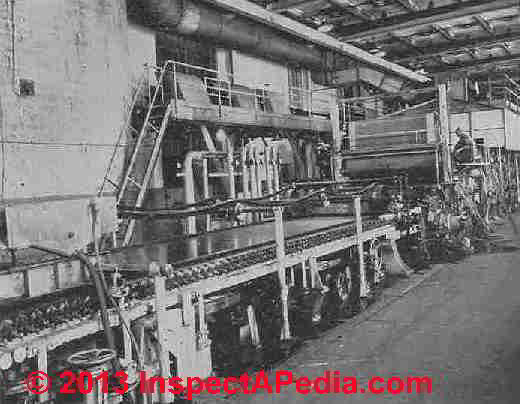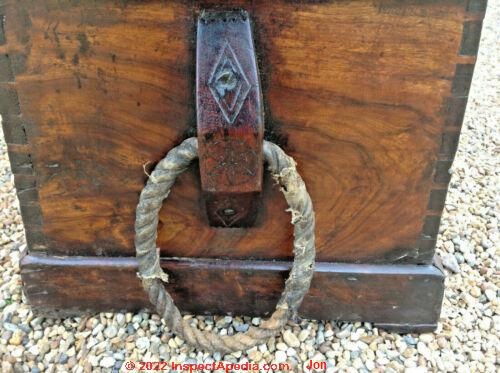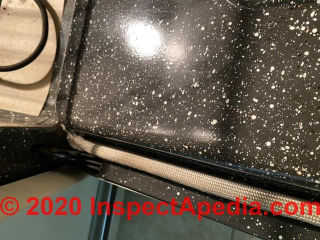 Asbestos Packings & Gaskets
Asbestos Packings & Gaskets
History, Manufacture &
Identification of Asbestos Gaskets, Ropes, & Packing Materials; asbestos exposure hazard assessment
- POST a QUESTION or COMMENT about asbestos gasket, rope & packing products: history, manufacture, use, identification, & properties
Asbestos gaskets, ropes, packings, automotive engines, valves, and similar products:
This article describes the properties, manufacture, history, & visual identification of asbestos packings, ropes and gaskets. We describe how asbestos rope, gaskets, & paper gasket material were manufactured and give the uses & properties of these products.
This articles series about the manufacture & use of asbestos-containing products includes detailed information on the production methods, asbestos content, and the identity and use of asbestos-containing materials.
InspectAPedia tolerates no conflicts of interest. We have no relationship with advertisers, products, or services discussed at this website.
- Daniel Friedman, Publisher/Editor/Author - See WHO ARE WE?
Asbestos Packings & Gaskets
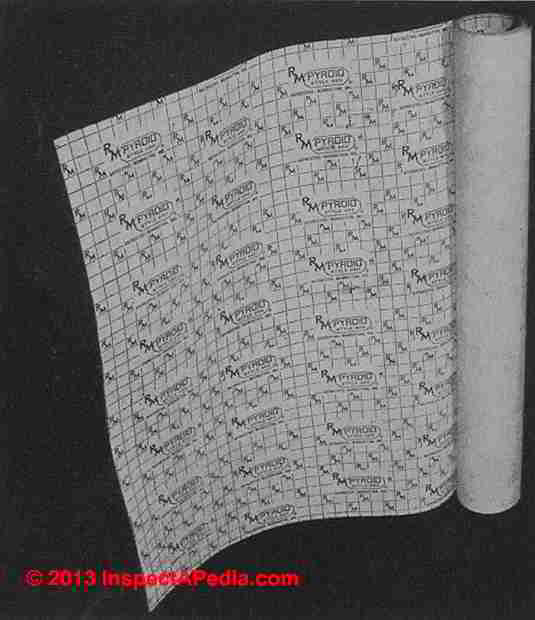 Asbestos was widely used in many forms of gaskets used in a very wide range of products ranging from automotive to plumbing, heating, the U.S. space program, and woodstoves. Asbestos-based gaskets offered benefits of heat and fire resistance as well as resistance to deformation from exposure to high temperature.
Asbestos was widely used in many forms of gaskets used in a very wide range of products ranging from automotive to plumbing, heating, the U.S. space program, and woodstoves. Asbestos-based gaskets offered benefits of heat and fire resistance as well as resistance to deformation from exposure to high temperature.
Introduction to Asbestos Rope & Paper Gaskets
The following text is Adapted from Rosato (1959) p. 178-184 [1] © 2013 InspectApedia.com
Introduction Asbestos packing and gasket seals have provided the best means of positively sealing hydraulic or pneumatic equipment.
No subject is of more pertinent interest to the mechanical engineer and plant executive than the proper operation of hydraulic or pneumatic equipment. Presses, valves, hoists, autoclaves, pumps and similarly controlled machinery can be a source of great expense when improperly sealed.
[Click to enlarge any image]
Packing is a compressible and resilient material used as a seal on moving parts. Gaskets are used wherever two stationary pieces of metal are brought together in equipment handling liquids or gases.
Gaskets are also termed stationary or static seals.
The most common use of gaskets is in the joining of flanges on pipe lines or valves. Seals and gaskets are identified basically by the method of application or type of construction;
i.e., asbestos-"Teflon" seals, asbestos-fiber sheeting, floating seals, mechanical seals, asbestos packings, rubber-sheet packings, V-U- and 0-rings, plastic seals, tadpole, silicone-rubber sheeting, asbestos rope, compression packings, asbestos felt seals, asbestos braiding packing, flexible metallic packings, and oil-retainer seals.
While the use of packings and gaskets is not new, there are always manufacturing and engineering problems associated with the development of new seals for new equipment. These types of problems involve the application of different types of asbestos-base seals.
The continually growing field of hydraulics and pneumatics has created a need for specialty packings and gaskets of varying characteristics and design to meet the many variations in speeds and temperatures.
Experience has shown that no one style or type of packing can be recommended as suitable for all different types of applications.
The principal reason for this is due to the variations to which the parts are subjected—pressure, medium of operation, temperature, availability of lubrication, metal clearances, speeds of operation, motion of operation (rotary or reciprocating) and allowable space of operation.
Chrysotile asbestos fibers, as well as crocidolite, are used in gaskets and packings along with such binders as natural rubbers, synthetic rubbers, asphalt, "Teflon," "Kel-F," phenolic resin, plasticizers, and other materials. Crocidolite is used principally in packing that requires acid resistance.
Asbestos can be made to have the ability to expand and contract with heat and cold in exactly the same manner as the metal it contacts. Chrysotile fibers are desirable in the seals because of their softness, durability, resistance to charring, silkiness, and slipperiness.
What is needed in the packing is low friction, resistance to high pressure, resistance to heat, and resistance to chemical gases. Having a combination of these requirements, asbestos surpasses all other materials in these properties.
Types of Asbestos Packing, Gasket, & Rope Products
Asbestos packings and gaskets are made by different techniques. Yarn can be twisted or braided into different shapes conforming to packing. or gasket requirements. The braided forms or asbestos fabrics can be coated, or impregnated with different compounds.
Cloth is one of the bases for sheet packing, folded, and wound packing. These packings in turn are formed into various shapes and sizes.
 Sheet asbestos packing is considered one of the first applications
of asbestos in the form of packing. This type of packing is
available with such different combinations as wire reinforced
asbestos fabric, graphite impregnated asbestos fabrics and
others. Metallic products can be made from woven cloth
which contains asbestos yarn—metal core.
Sheet asbestos packing is considered one of the first applications
of asbestos in the form of packing. This type of packing is
available with such different combinations as wire reinforced
asbestos fabric, graphite impregnated asbestos fabrics and
others. Metallic products can be made from woven cloth
which contains asbestos yarn—metal core.
This type of construction, impregnated with the various binders, has been very popular and useful in the manufacture of gaskets and packings.
Numerous government specifications are available which pertain to asbestos gaskets and packings. The asbestos packing or sheet requirements generally specify type and amount of fiber in proportion to binders and other additives. Parts can be used at temperatures up to about 700°F.
For example, for the higher temperature resistant rubber packings, the composition generally specified includes 70 to 75 per cent, by weight asbestos fiber, 9 to 16 per cent rubber, 1 1/2 to 1 per cent sulfur, and 10 to 14 per cent mineral fillers.
Braided asbestos packing, which is rubberized and graphited, is suitable for high pressure and high temperature applications. See Figure 10.1.
Approximately 10 per cent rubber together with such suitable fillers as talcum and graphite is added in this type of product in order to thicken and build up the body of packings.
Graphite is a very popular additive since it principally provides low frictional and binding properties.
Packing for high temperature must be firm and hard. The packing which is vulcanized in large coils is generally difficult to force into engineered cavities of equipment such as stuffing boxes. A common procedure is to wind these coils in spirals during the vulcanizing process so that they can be easily installed.
Figure 10.1. Asbestos braided and woven packings_froni top to bottom—interlocked braided, square-plaited braid, braid over braid, and twisted.
Although graphite is a popular ingredient in packings, it is not suitable in packings which will be in contact with stainless steel shafts, rods, and valve stems. In these applications pitting of the metal will occur when packings are lubricated with graphite.
Fabricated packing get its name from being made by molding asbestos cloth with rubber. Different types of synthetic rubber as well as natural rubber are used in order to withstand operating temperatures up to 700°F.
Special packings made to withstand high steam pressures, which in turn are subjected to both high pressures and temperatures, are similar to millboard and paper products.
See Figure 10.2 below. The special packings are made in different shapes and sizes including ring-type gaskets, V-grooves, and others. Medium length asbestos is generally used.
The mixture can be 66 per cent fiber; the remaining constituents are magnesia, iron oxide, clay, barite, cellulose and/or graphite.
Below we show Figure 10.2. the Fourdrinier paper machine adapted for manufacture of asbestos paper sheet gasketing material. - Courtesy Armstrong Cork Co.
Resins, gums, or rubber are sometimes added to provide for more bonding action.
These type of binders are generally dissolved in a volatile solvent such as naphtha and toluene. The mixtures are pressed into any desired shape depending on specific applications.
They can be reinforced with copper or lead foil.
These mixtures can be directed through heated calenders and pressed into sheets. See Figure 10.3 below.
Figure 10.3. Compressed asbestos sheet packing. - Courtesy Raybestos Manhattan, Inc.
Automatic mechanisms are available with asbestos sheeters to control the opening between the front and back rolls as the machine forms a sheet of asbestos from which packings and gaskets are made.
In actual operation the stock is built up on a steam-heated roll to the required thickness, layer by layer, as the volatile liquids are evaporated.
Even pressure must be maintained by the smaller front roll which requires that the opening between the rolls be widened as the sheet becomes thicker.
This adjustment of the opening between the rolls is automatically accomplished by means of a ratchet controlled worm adjustment driven by controls directed from the front roll.
Asbestos-rubber compound sheets are sometimes not completely vulcanized until after the material is installed and heat is applied in the packing or gasket area.
This allows the packing to become a well fitted part in the machine, making it almost impossible for a leak or blowout to occur.
Asbestos fabric packings are also available constructed of an outer cover of asbestos cloth wrapped around an intercore of resilient material. These products are also referred to as "tadpole" gasketing tape.
The outer cloth can be made with or without metallic inserts. Synthetic rubber, silicone, or "Teflon" can be used as the binder in the cloth. The cores can be made with asbestos alone, synthetic rubber, and a metal such as stainless steel.
The shape of the tadpole tape can vary from round to flat gaskets.
Asbestos wick packing is a soft twisted packing made from asbestos roving and is principally used in dry heat where there is relatively no steam pressure involved. The asbestos wick is also available in plied form to make the asbestos rope which can also be used as a packing.
When it is made in the form of rope, it is usually supplied on reels so that any length can be cut. In the manufacture of rope packing, the rope is covered with one or two braids of asbestos yarns in order to prevent the rope from untwisting during handling.
Asbestos in Automotive Engine Gaskets
Reader Question: can we identify engines whose gaskets contain asbestos
15 August 2015 Stewart Willis said:
I work in a Detroit Diesel engine re-manufacturing facility and occasionally come across engines from the 70's and 80's when asbestos gaskets were frequently used. It is hard to get management to acknowledge the possibility of asbestos being present in some gaskets.
Is there a data base that has serial numbers of engines containing asbestos, split lines in those numbers to indicate when gaskets changed content, etc. It would be nice to have pictures to compare actual engines containing asbestos with ones I work on.
Any assistance would be appreciated. My uncle died of mesothelioma so I know first hand how serious this is.
Reply:
Good question, Stewart. I've not been able to find such a database of engine serial numbers vs. gasket types used, though there has been research particularly pointing to diesel engines.
Even if you know the engine year you may not know if there was prior work on the engine that changed out its original head gasket or other gasket to a later one that didn't use asbestos.
For engine gaskets that are sandwiched between metal plates and that can be removed intact, the hazard of asbestos particle release is probably pretty low - a view supported by some research on worker exposure to asbestos from automotive gaskets::
Blake (2006) found that
... automobile mechanics who worked with asbestos-containing gaskets may have been exposed to concentrations of airborne asbestos concentrations approximately 100 times lower than the current Occupational Safety and Health Administration (OSHA) Permissible Exposure Limit (PEL) of 0.1 f/cc.
And the next year Madl (2007) confirmed that
The weight of evidence indicates that the use of hand tools and hand-operated power tools to remove or install gaskets or packing as performed by pipefitters or other tradesmen in nearly all plausible situations would not have produced airborne concentrations in excess of contemporaneous regulatory levels.
For engine work in which an un-laminated gasket is adhered to the head (certainly that's what I did in the 1960's) and that has to be soaked and scraped off, it would make sense and probably be least costly and safest to use a procedure that did not create airborne dust at all. Could you specify such a procedure?
If so we could publish it here for wider comment.
Watch out: asbestos may be found in modern automotive gaskets as well. See Boardman (1992) cited below.
Research on Asbestos Gaskets
Some patent research gives us an idea of when asbestos-containing engine gaskets were and later were not in common use, and there has been some research on asbestos exposure from engine gasket use that I will cite below:
- Ascencio, Roman J., Brockhaus Eugene A., Furstenburg Alvin J, ""Head gasket assembly having parts therein." U.S. Patent 3,565,449, issued February 23, 1971.
- Blake, Charles L., G. Scott Dotson, and Raymond D. Harbison. "Assessment of airborne asbestos exposure during the servicing and handling of automobile asbestos-containing gaskets." Regulatory toxicology and Pharmacology 45, no. 2 (2006): 214-222.
Abstract:
Five test sessions were conducted to assess asbestos exposure during the removal or installation of asbestos-containing gaskets on vehicles. All testing took place within an operative automotive repair facility involving passenger cars and a pickup truck ranging in vintage from late 1960s through 1970s. A professional mechanic performed all shop work including engine disassembly and reassembly, gasket manipulation and parts cleaning.
Bulk sample analysis of removed gaskets through polarized light microscopy (PLM) revealed asbestos fiber concentrations ranging between 0 and 75%. Personal and area air samples were collected and analyzed using National Institute of Occupational Safety Health (NIOSH) methods 7400 [phase contrast microscopy (PCM)] and 7402 [transmission electron microscopy (TEM)].
Among all air samples collected, approximately 21% (n = 11) contained chrysotile fibers. The mean PCM and phase contrast microscopy equivalent (PCME) 8-h time weighted average (TWA) concentrations for these samples were 0.0031 fibers/cubic centimeters (f/cc) and 0.0017 f/cc, respectively.
Based on these findings, automobile mechanics who worked with asbestos-containing gaskets may have been exposed to concentrations of airborne asbestos concentrations approximately 100 times lower than the current Occupational Safety and Health Administration (OSHA) Permissible Exposure Limit (PEL) of 0.1 f/cc. - Boardman, Thomas A. "Gasket assembly." U.S. Patent 5,145,190, issued September 8, 1992.
Excerpt: In U.S. Pat. No. 3,565,449 to Ascencio et al., a main gasket body is a metal sheet with impregnated asbestos on each side. - Liukonen, Larry R., and Francis W. Weir. "Asbestos exposure from gaskets during disassembly of a medium duty diesel engine." Regulatory toxicology and pharmacology 41, no. 2 (2005): 113-121.
Abstract:
Diesel engines have historically used asbestos-containing gaskets leading to concerns of fiber release and mechanic exposure.
Other published studies regarding asbestos fiber release during gasket removal have reported on short-duration events; were conducted under simulated work conditions; or had other limitations.
There are no comprehensive studies relating to diesel engine gaskets under conditions similar to those reported herein, evaluating asbestos fiber release from gaskets during all facets of a complete disassembly and cleaning of a medium duty diesel engine in a busy repair and service shop by a journeyman mechanic. Asbestos content of all gaskets was identified; all disassembly tasks were described and timed; and personal and area air monitoring was conducted for each task.
Twenty seven of thirty three gaskets contained chrysotile asbestos in concentrations that ranged from 5 to 70%. All but one air monitoring sample reported results below the limit of reliable detection even though plumes of visible dust were evident during various removal, cleaning, and buffing procedures.
The detection limit for airborne asbestos fibers in this investigation was influenced by the presence of other shop dust in the air.
Our investigation demonstrates that using shop-standard procedures in an established repair facility, a journeyman mechanic has very little potential for exposure to airborne asbestos fibers during disassembly of an engine, approximately 10% or less than that currently considered to be acceptable by OSHA. - Madl, Amy K., Katherine Clark, and Dennis J. Paustenbach. "Exposure to airborne asbestos during removal and installation of gaskets and packings: a review of published and unpublished studies." Journal of Toxicology and Environmental Health, Part B 10, no. 4 (2007): 259-286.
Abstract:
In recent years, questions have been raised about the health risks to persons who have been occupationally exposed to asbestos-containing gaskets and packing materials used in pipes, valves, and machinery (pumps, autos, etc.).
Up until the late 1970s, these materials were widely used throughout industrial and maritime operations, refineries, chemical plants, naval ships, and energy plants.
Seven simulation studies and four work-site industrial hygiene studies of industrial and maritime settings involving the collection of more than 300 air samples were evaluated to determine the likely airborne fiber concentrations to which a worker may have been exposed while working with encapsulated asbestos-containing gaskets and packing materials.
Each study was evaluated for the representativeness of work practices, analytical methods, sample size, and potential for asbestos contamination (e.g., insulation on valves or pipes used in the study). Specific activities evaluated included the removal and installation of gaskets and packings, flange cleaning, and gasket formation.
In all but one of the studies relating to the replacement of gaskets and packing using hand-held tools, the short-term average exposures were less than the current 30-min OSHA excursion limit of 1 fiber per cubic centimeter (f/cc) and all of the long-term average exposures were less than the current 8-h permissible exposure limit time-weighted average (PEL-TWA) of 0.1 f/cc.
The weight of evidence indicates that the use of hand tools and hand-operated power tools to remove or install gaskets or packing as performed by pipefitters or other tradesmen in nearly all plausible situations would not have produced airborne concentrations in excess of contemporaneous regulatory levels. - Paustenbach, Dennis J., Amy K. Madl, Ellen Donovan, Katherine Clark, Kurt Fehling, and Terry C. Lee. "Chrysotile asbestos exposure associated with removal of automobile exhaust systems (ca. 1945–1975) by mechanics: Results of a simulation study." Journal of Exposure Science and Environmental Epidemiology 16, no. 2 (2006): 156-171.
- Stecher, Friedhelm, Josef Fazekas, Paul Johren, and Martin Morsbach. "Cylinder head gasket for internal-combustion engine." U.S. Patent 3,970,322, issued July 20, 1976.
- Victor, John H., Joseph B., "Laminated metal and asbestos gasket." U.S. Patent 2,130,110, issued September 13, 1938.
Asbestos also may appear in more subtle forms in gasket materials that were themselves coated in asbestos-containing talc used as a lubricant.
...
Reader Comments, Questions & Answers About The Article Above
Below you will find questions and answers previously posted on this page at its page bottom reader comment box.
Reader Q&A - also see RECOMMENDED ARTICLES & FAQs
On 2022-05-20 by Jon - Is the rope found on a old sea chest (as per photo) likely to contain asbestos?
Is the rope found on a old sea chest (as per photo) likely to contain asbestos?
This Q&A appeared originally at ANTIQUE CHEST WOOD & FABRIC
On 2022-05-20 by InspectApedia-911 (mod) - Rope handles on antique sea chest: asbestos?
 Photo: an asbestos-rope gasket (Kraner 2022) cited in detail below.
Photo: an asbestos-rope gasket (Kraner 2022) cited in detail below.
@Jon,
Thank you for the old sea-chest photo and the question.
No, the rope handle on the sea chest is not likely to be an asbestos product.
But it's right to ask the question.
Asbestos "rope" was used extensively in maritime applications as it was fire-resistant, but it'd have been more-useful as a gasket or packing material than as a lifting material where strength is important.
And in those applications the asbestos "rope" packing is woven, not twisted.
Twisted ropes in maritime use were typically a jute product.
The photo below, presumably of an asbestos rope gasket used in maritime applications is from
- Kraner, Inna, J.D., Ship Worker Gets Mesothelioma From Using Asbestos Rope, (2022) [Web article] Expert Institute, 48 Wall Street, 16th Floor,
New York, NY 10005 USA, Tel: (888) 858-9511 Email: info@expertinstitute.com, retrieved 2022/05/20, original source: www.expertinstitute.com/resources/case-studies/ship-worker-gets-mesothelioma-using-asbestos-rope/
Excerpt:
His job involved removing old insulation from the valves and putting new wicking and rope packing in the valves. Both of these jobs created lots of asbestos dust.
The worker did not know about asbestos but noticed that the rope was “dry, white and powdery.” When the worker cut the rope, it produced a lot of dust.
On 2020-07-10 by Twiz - Asbestos use in an antique cotton candy machine - safe to use?
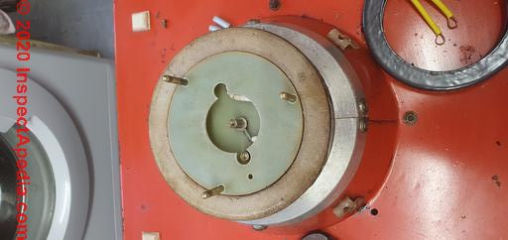 Hi I've inherited my family candy floss machine, its around 40-50 years old, the make of it is 'wisper' Associated leisure sales limited,
Hi I've inherited my family candy floss machine, its around 40-50 years old, the make of it is 'wisper' Associated leisure sales limited,
I have recently replaced ine of the elements and a heat isolation ring, it has 3 of those altogether, only one has been replaced, but I believe its as old, just never used and was given to me as a spare,
my dad recently mentioned in passing that he heard they were made of asbestos, so I a bit concerned with how safe the candy floss would actually be as well as safety using the machine, any advice would be appreciated, this is the lower ring (looks like cardboard type material, thanks
On 2020-07-11 by (mod) - asbestos in candy floss (cotton candy) Machine: Wisper Associated Leisuer Sales Ltd.
Twiz
Thank you for the photo and interesting question about asbestos gaskets in a machine producing edibles: candy floss. (For other readers, candy floss is synonymous with "cotton candy".)
Twiz
If the asbestos suspect gasket is a hard plastic and un-damaged (I am not sure which is the part in your photo is the lower ring) then it's not likely to shed particles at a measurable level, regardless of its composition.
If the asbestos-suspect gasket is covered by other parts when the machine is assembled it's not likely to be a detectable hazard.
If the questionable part is not in contact with the candy-floss ingredients, then again there's not likely to be a detectable asbestos release into the candy
If the asbestos suspect part is a hard plastic and un-damaged (I am not sure which is the part in your photo is the lower ring) then it's not likely to shed particles at a measurable level, regardless of its composition.
If the questionable part is not in contact with the candy-floss ingredients, then again there's not likely to be a detectable asbestos release into the candy.
In the most-aggressive or most-careful test that occurs to me one might collect and sample for asbestos both surrounding dust near the machine's internal parts when it has been operating for a time, and a sample of the candy floss.
Bottom line: while my understanding of the machine and its operation is close to nil, from what we see it seems unlikely that there's a demonstrable asbestos hazard in the candy floss from the machine's operation.On 2020-07-12 by Twiz
Thankyou for your reply, its not hard plastic but what feels and looks a little like cardboard material or paper mache, its around the central hard plastic circle with cut outs, it is sandwhiched between two hard metal cages which house the elements (black) and the top cone/funnel shape, and doesnt come in contact with the sugar/candy floss, but I will inspect after its been run to see if I notice the dust you referred to, thankyou so much for your help, much appreciated.
On 2020-05-29 by Chris - might an old Whirlpool electric overn door gasket contain asbestos?
I have an old electric whirlpool oven with this rope gasket around the door. I’m not sure of the exact oven age, though it is quite old. Is there any chance this gasket might contain asbestos?
On 2020-05-29 - by (mod) -
Yes Chris
Question: disposal of asbestos in isolation valve gland packings
Apr 2, 2015) Anonymous said:
When disposing of an isolation valve that has asbestos containing gland packing, can it be disposed of with other scrap metal or does it need to go with asbestos contaminated waste.
Reply:
Anon:
I don't know what your state or provincial department of environment would advise. Construction debris regulations vary widely among jurisdictions. If the asbestos material is not in significant quantity (you cite a single valve making the quantity most likely trivial) and considering that most of the material if not all is inside the valve, my opinion is that the hazard is most likely below the limits of detection.
...
Continue reading at ASBESTOS FILTERS or select a topic from the closely-related articles below, or see the complete ARTICLE INDEX.
Or see these
Recommended Articles
Suggested citation for this web page
ASBESTOS PACKINGS & GASKETS at InspectApedia.com - online encyclopedia of building & environmental inspection, testing, diagnosis, repair, & problem prevention advice.
Or see this
INDEX to RELATED ARTICLES: ARTICLE INDEX to ASBESTOS HAZARDS
Or use the SEARCH BOX found below to Ask a Question or Search InspectApedia
Ask a Question or Search InspectApedia
Try the search box just below, or if you prefer, post a question or comment in the Comments box below and we will respond promptly.
Search the InspectApedia website
Note: appearance of your Comment below may be delayed: if your comment contains an image, photograph, web link, or text that looks to the software as if it might be a web link, your posting will appear after it has been approved by a moderator. Apologies for the delay.
Only one image can be added per comment but you can post as many comments, and therefore images, as you like.
You will not receive a notification when a response to your question has been posted.
Please bookmark this page to make it easy for you to check back for our response.
IF above you see "Comment Form is loading comments..." then COMMENT BOX - countable.ca / bawkbox.com IS NOT WORKING.
In any case you are welcome to send an email directly to us at InspectApedia.com at editor@inspectApedia.com
We'll reply to you directly. Please help us help you by noting, in your email, the URL of the InspectApedia page where you wanted to comment.
Citations & References
In addition to any citations in the article above, a full list is available on request.
- [1] ASBESTOS HISTORY & PROPERTIES [Book online] D.V. Roasato, engineering consultant, Newton MA, Reinhold Publishing Co., NY, 1959, Library of Congress Catalog No. 59-12535. We are in process of re-publishing this interesting text. Excerpts & adaptations are found in InspectApedia.com articles on asbestos history, production & visual identification in and on buildings.
- [2] "Asbestos in Plastic Compositions", A.B. Cummins, Modern Plastics [un-dated, pre 1952]
- [5] "Characterization of asbestos exposure among automotive mechanics servicing and handling asbestos-containing materials", Gary Scott Dotson, University of South Florida, 1 June 2006, web search 3/9/2012 original source: scholarcommons.usf.edu/cgi/viewcontent.cgi?article=3505&context=etd [copy on file as /hazmat/Automotive_Asbestos_Exposure.pdf ].
- [7] Asbestos products and their history and use in various building materials such as asphalt and vinyl flooring includes discussion which draws on ASBESTOS, ITS INDUSTRIAL APPLICATIONS, ROSATO 1959, D.V. Rosato, engineering consultant, Newton, MA, Reinhold Publishing, 1959 Library of Congress Catalog Card No.: 59-12535 (out of print, text and images available at InspectAPedia.com).
- In addition to citations & references found in this article, see the research citations given at the end of the related articles found at our suggested
CONTINUE READING or RECOMMENDED ARTICLES.
- Carson, Dunlop & Associates Ltd., 120 Carlton Street Suite 407, Toronto ON M5A 4K2. Tel: (416) 964-9415 1-800-268-7070 Email: info@carsondunlop.com. Alan Carson is a past president of ASHI, the American Society of Home Inspectors.
Thanks to Alan Carson and Bob Dunlop, for permission for InspectAPedia to use text excerpts from The HOME REFERENCE BOOK - the Encyclopedia of Homes and to use illustrations from The ILLUSTRATED HOME .
Carson Dunlop Associates provides extensive home inspection education and report writing material. In gratitude we provide links to tsome Carson Dunlop Associates products and services.


